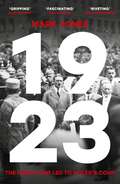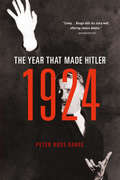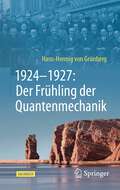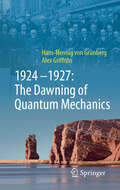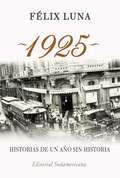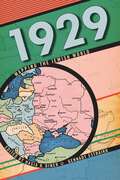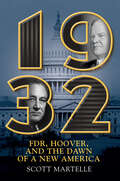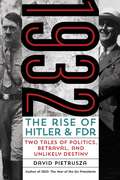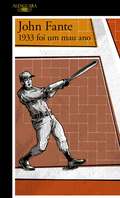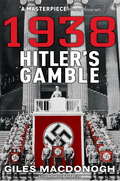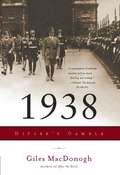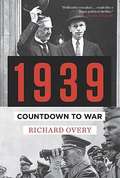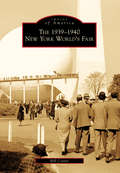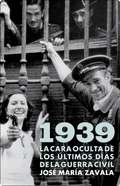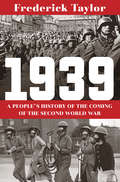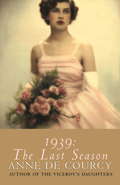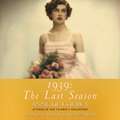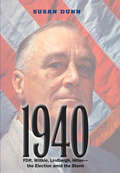- Table View
- List View
1923: The Forgotten Crisis in the Year of Hitler’s Coup
by Mark Jones'Gripping . . . thoroughly researched and beautifully written . . . a warning for our times' Alex Watson, author of Ring of Steel'Fascinating . . . shows powerfully that there was nothing inevitable about the survival of Germany's young democracy in that year - nor about its death a decade later. A timely reminder' Katja Hoyer, author of Beyond the WallThe astonishing year when German democracy faced crisis and near destruction.1923 was one of the most remarkable years of modern European history. In January, France and Belgium militarily occupied Germany's economic heartland, the Ruhr; triggering a series of crises that almost spiralled out of control. Hyperinflation plunged millions into poverty. The search for scapegoats empowered political extremes. Hitler's populism ascended to national prominence. Communists, Nazis, separatists all thought that they could use the crises to destroy democracy. None succeeded. 1923 was the year of Hitler's first victory - and his first defeat. Fanning the flames of instability, anti-government and antisemitic sentiment, the Nazis' abortive yet pivotal putsch in a Munich beer hall failed when they were abandoned by their likeminded conservative allies. Drawing on previously unseen sources, Mark Jones weaves together a thrilling and resonant narrative of German lives in this turbulent time. Tracing Hitler's rise, we see how political pragmatism and international cooperation eventually steered the nation away from total insurrection. A decade later, when Weimar democracy eventually succumbed to tyranny, the warnings from 1923 - rising of nationalist rhetoric, fragile European consensus, and underestimation the of the enemies of liberalism - became only too apparent.This account of the republic's convulsions and survival offers a gripping image of a modern society in extreme crisis.
1924: The Year That Made Hitler
by Peter Ross RangeThe dark story of Adolf Hitler's life in 1924--the year that made a monsterBefore Adolf Hitler's rise to power in Germany, there was 1924. This was the year of Hitler's final transformation into the self-proclaimed savior and infallible leader who would interpret and distort Germany's historical traditions to support his vision for the Third Reich. Everything that would come--the rallies and riots, the single-minded deployment of a catastrophically evil idea--all of it crystallized in one defining year. 1924 was the year that Hitler spent locked away from society, in prison and surrounded by co-conspirators of the failed Beer Hall Putsch. It was a year of deep reading and intensive writing, a year of courtroom speeches and a treason trial, a year of slowly walking gravel paths and spouting ideology while working feverishly on the book that became his manifesto: Mein Kampf.Until now, no one has fully examined this single and pivotal period of Hitler's life. In 1924, Peter Ross Range richly depicts the stories and scenes of a year vital to understanding the man and the brutality he wrought in a war that changed the world forever.
1924–1927: Der Frühling der Quantenmechanik
by Hans-Hennig von GrünbergSeines Heuschnupfens wegen verbrachte Werner Heisenberg im Juni 1925, vor nun bald hundert Jahren, zehn Tage auf der Insel Helgoland, wo er einen Artikel schrieb, der als der Beginn der Geschichte der modernen Quantentheorie angesehen werden kann. Im Oktober 1927 fand die fünfte Solvay-Konferenz in Brüssel statt, die wohl berühmteste Konferenz in der Geschichte der Physik, und brachte die spannende Entstehungsgeschichte der Quantenmechanik zu ihrem vorläufigen Ende. In diesen Jahren zwischen 1925 und 1927 entwickelten acht Physiker aus fünf Ländern eine Theorie, die das physikalische Verständnis unserer Welt radikal verändert sollte. Mit diesem Buch wandert man vom September 1924 bis zum Oktober 1927 durch die Zeit und erfährt dabei in Form von Monatsberichten, wie die Quantenmechanik entstanden ist, was die handelnden Personen erlebt und gedacht, in welcher Zeit sie gelebt haben und wie aus dem Zusammenspiel Einzelner langsam das gemeinsame Ganze entstanden ist. Das Buch wendet sich an Laien, die sich von der Quantenmechanik faszinieren lassen wollen und dabei verstehen werden, dass diese Theorie wie Anita Berber, der Jazz oder die Erfindung des Fernsehens ein typisches Kind der 1920er Jahre ist.
1924–1927: The Dawning of Quantum Mechanics
by Hans-Hennig von Grünberg Alex GriffithsIn June of 1925, almost a hundred years ago, Werner Heisenberg spent ten days on the island of Heligoland - thanks to his hayfever. This respite afforded him the time to write an article that would mark the beginning of the history of modern quantum theory. Two years later, in October of 1927, the fifth Solvay Conference, arguably the most famous gathering in the history of physics, took place in Brussels, bringing the riveting story of the origins of quantum mechanics to a close. During this crucial and relatively short period between 1925 and 1927, eight physicists from five countries developed a theory that would radically change the physical understanding of our world and would become the basis for almost all advanced technologies: transistors, lasers, light-emitting diodes, medical imaging, the electron microscope and much more. The reader will travel through time from September 1924 to October 1927 and learn by way of monthly entries how quantum mechanics came into being, what the people involved experienced and thought in the context of the time they lived in, and how a unified whole slowly emerged from the interactions of these individuals. The book is aimed at laypeople who are fascinated by quantum mechanics and its history. They will learn that this theory, like Anita Berber, jazz or the invention of television, is a characteristic child of the 1920s.
1925. HISTORIA DE UN AÑO SIN... (EBOOK)
by Felix Luna1925, un año sin mayor significación, es celebrado por Félix Luna en este libro diferente a los que integran su vasta obra. Se trata de diálogos entre gente muy diversa, en los que convergen los temas que en ese momento apasionaban a los argentinos. Qué motivo llevó al conocido historiador a tejer este ejercicio de imaginación? Lo confiesa en el prólogo. Pero aunque no lo hiciera, 1925 es un deleite para la lectura por la variedad de personajes que aparecen en estas páginas y por la brecha que se define entre ese momento histórico -relativamente cercano- y el mundo de hoy, a través de una vida, la del autor.
1925. Historias de un año sin historia
by Felix LunaA través de diálogos entre gente muy diversa, se revelan los temas queen ese momento apasionaban a los argentinos. 1925, un año sin mayor significación, es celebrado por Félix Luna eneste libro diferente a los que integran su vasta obra. «1925» es undeleite para la lectura por los diversos personajes, lo variopinto delos lenguajes usados, el colorido de la temática desplegaday por la brecha que se define entre ese momento histórico -relativamentecercano- y el mundo de hoy, a través de una vida, la del autor.
1928 Diagnostics: Fighting Antibiotics Resistance
by Daniela Beyersdorfer Ariel D. SternIn 2019, the co-founders of the Swedish medical start-up 1928 Diagnostics, CEO Dr. Kristina Lagerstedt and COO Dr. Susanne Staaf, had to pick the right business model to commercialize their novel technology to hospitals and health care providers. Developed in partnership with research hospitals to help fight the global antibiotic resistance crisis, the firm's cloud-based technology platform helped partners identify resistant genes and mutations in bacteria more quickly and accurately, allowing for easier outbreak cluster tracking in support of hospital infection control management, as well as better diagnostics and antibiotic selection. By 2019, they had raised $5 million, employed 16 people, and had their tool deployed at 24 partner sites in 10 different countries. Their decisions on which markets to focus on and with which business model would crucially impact the young firm's chances at successfully converting existing users and attracting new clients.
1929: Mapping the Jewish World (Alternative Criminology #13)
by Gennady Estraikh Hasia R DinerWinner of the 2013 National Jewish Book Award, Anthologies and CollectionsThe year 1929 represents a major turning point in interwar Jewish society, proving to be a year when Jews, regardless of where they lived, saw themselves affected by developments that took place around the world, as the crises endured by other Jews became part of the transnational Jewish consciousness. In the United States, the stock market crash brought lasting economic, social, and ideological changes to the Jewish community and limited its ability to support humanitarian and nationalist projects in other countries. In Palestine, the anti-Jewish riots in Hebron and other towns underscored the vulnerability of the Zionist enterprise and ignited heated discussions among various Jewish political groups about the wisdom of establishing a Jewish state on its historical site. At the same time, in the Soviet Union, the consolidation of power in the hands of Stalin created a much more dogmatic climate in the international Communist movement, including its Jewish branches. Featuring a sparkling array of scholars of Jewish history, 1929 surveys the Jewish world in one year offering clear examples of the transnational connections which linked Jews to each other—from politics, diplomacy, and philanthropy to literature, culture, and the fate of Yiddish—regardless of where they lived. Taken together, the essays in 1929 argue that, whether American, Soviet, German, Polish, or Palestinian, Jews throughout the world lived in a global context.
1930: The Story of a Baseball Season When Hitters Reigned Supreme
by Lew FreedmanThe 1930 Major League baseball season was both marvelous and horrendous, great for hitters, embarrassing for pitchers. In totality it was just this side of insane as an outlier among all seasons.Major League Baseball began with the founding of the National League in 1876. In the 145 seasons since then, one season stands out as unique for the astounding nature of hitting: 1930.A flipside of 1968&’s &“Year of the Pitcher,&” when the great St. Louis Cardinals Bob Gibson compiled a 1.12 earned run average and Detroit Tigers Denny McLain won 31 games, the 1930 season was when the batters reigned supreme. During this incredible season, more than one hundred players batted .300, the entire National League averaged .300, ten players hit 30 or more home runs, and some of the greatest individual performances established all-time records. From New York Giants Bill Terry&’s .401 average—the last National Leaguer to hit over .400—to the NL-record 56 home runs and major league–record 192 runs batted in by Chicago Cubs Hack Wilson, the 1930 season is a wild, sometimes unbelievable, often wacky baseball story.Breaking down the anomaly of the season and how each team fared, veteran journalist Lew Freeman tells the story of a one-off year unlike any other. While the greats stayed great, and though some pitchers did hold their own—with seven winning 20 or more games, including 28 by Philadelphia Athletics&’ Lefty Grove and 25 by Cleveland Indians&’ Wes Ferrell—Freedman shares anecdotes about those players that excelled in 1930, and only 1930. More than ninety years later, 1930 offers insight into a season that still stands the test of time for batting excellence.
1932: FDR, Hoover, and the Dawn of a New America
by Scott MartelleA fascinating behind-the-scenes look at a year in American history that still resonates today, 1932: FDR, Hoover, and the Dawn of a New America tells the story of a battered nation fighting for its own future amid the depths of the Great Depression. At the start of 1932, the nation&’s worst economic crisis has left one-in-four workers without a job, countless families facing eviction, banks shutting down as desperate depositors withdraw their savings, and growing social and political unrest from urban centers to the traditionally conservative rural heart of the country. Amid this turmoil, a political decision looms that will determine the course of the nation. It is a choice between two men with very diferent visions of America: Incumbent Republican Herbert Hoover with his dogmatic embrace of small government and a largely unfettered free market, and New York&’s Democratic Governor Franklin Delano Roosevelt and his belief that the path out of the economic crisis requires government intervention in the economy and a national sense of shared purpose. Now veteran journalist Scott Martelle provides a gripping narrative retelling of that vitally significant year as social and political systems struggled under the weight of the devastating Dust Bowl, economic woes, rising political protests, and growing demand for the repeal of Prohibition. That November, voters overwhelmingly rejected decades of Republican rule and backed Roosevelt and his promise to redefine the role of the federal government while putting the needs of the people ahead of the wishes of the wealthy. Deftly told, this illuminating work spotlights parallel events from that pivotal year and brings to life figures who made headlines in their time but have been largly forgotten today. Ultimately, it is the story of a nation that, with the help of a leader determined to unite and inspire, took giant steps toward a new America.
1932: The Rise of Hitler and FDR--Two Tales of Politics, Betrayal, and Unlikely Destiny
by David PietruszaTwo Depression-battered nations confronted destiny in 1932, going to the polls in their own way to anoint new leaders, to rescue their people from starvation and hopelessness. America would elect a Congress and a president ebullient aristocrat Franklin Roosevelt or tarnished Wonder Boy Herbert Hoover. Decadent, divided Weimar Germany faced two rounds of bloody Reichstag elections and two presidential contests doddering reactionary Paul von Hindenburg against rising radical hate-monger Adolf Hitler. The outcome seemed foreordained unstoppable forces advancing upon crumbled, disoriented societies. A merciless Great Depression brought greater perhaps hopeful, perhaps deadly transformation: FDR s New Deal and Hitler s Third Reich. But neither outcome was inevitable. Readers enter the fray through David Pietrusza s page-turning account: Roosevelt s fellow Democrats may yet halt him at a deadlocked convention. 1928 s Democratic nominee, Al Smith, harbors a grudge against his one-time protege. Press baron William Randolph Hearst lays his own plans to block Roosevelt s ascent to the White House. FDR s politically-inspired juggling of a New York City scandal threatens his juggernaut. In Germany, the Nazis surge at the polls but twice fall short of Reichstag majorities. Hitler, tasting power after a lifetime of failure and obscurity, falls to Hindenburg for the presidency also twice within the year. Cabals and counter-cabals plot. Secrets of love and suicide haunt Hitler. Yet guile and ambition may yet still prevail. 1932 s breathtaking narrative covers two epic stories that possess haunting parallels to today s crisis-filled vortex. It is an all-too-human tale of scapegoats and panaceas, class warfare and racial politics, of a seemingly bottomless depression, of massive unemployment and hardship, of unprecedented public works/infrastructure programs, of business stimulus programs and damaging allegations of political cronyism, of waves of bank failures and of mortgages foreclosed, of Washington bonus marches and Berlin street fights, of once-solid financial empires collapsing seemingly overnight, of rapidly shifting social mores, and of mountains of irresponsible international debt threatening to crash not just mere nations but the entire global economy. It is the tale of spell-binding leaders versus bland businessmen and out-of-touch upper-class elites and of two nations inching to safety but lurching toward disaster. It is 1932 s nightmare with lessons for today. "
1933
by Philip Metcalfe"Using letters, diaries, and memoirs, Metcalfe distills the personalities, viewpoints, and day-to-day reactions of five alert and often directly involved witnesses to Hitler's consolidation of power. They are: U.S. Ambassador to Germany, William Dodd, and his high-spirited daughter, Martha; Bella Fromm, a glamorous German society columnist who was Jewish and made no secret of it; Ernest Hanfstaengl, Hitler's somewhat buffoonish foreign-press chief; and Rudolf Diels, the first head of the Gestapo." --Publishers Weekly
1933 foi um mau ano
by John FanteA um ano de terminar o liceu, Dominic Molise não vê o dia de sair da casa familiar, onde dominam a figura do pai, um pedreiro dado a aventuras extraconjugais, e a da mãe beata, que jura ver a Virgem Maria no galinheiro do quintal. Dominic sonha ser uma estrela do baseball, agraciado com grandes vitórias, o reconhecimento público e um grande amor. Mas, em vez disso, está preso numa cidadezinha dilacerada pela pobreza, numa família em que tudo o que se espera é que os filhos façam o mesmo que os pais e os avós. Se a ambição de jogar baseball parece cada vez mais distante, os assuntos do coração também não lhe correm de feição. A história de um jovem dividido entre a tradição e a liberdade, entre a família e a autodeterminação, numa sociedade ressequida por uma devastadora crise económica. A história da luta de um indivíduo que personifica a luta de toda uma classe no tempo da Grande Crise Económica dos anos 30. Um romance cómico e comovente sobre a juventude e a sua dissolução na vida adulta.
1936 ... On the Continent
by Eugene FodorThis guide takes you on a prewar journey through 30 European countries, including the British Isle.
1938: Hitler's Gamble
by Giles MacDonoghIn this masterly new work, acclaimed historian Giles MacDonogh explores the moment when Hitler gambled everything. Until 1938, Hitler could be dismissed as a ruthless but efficient dictator, a problem to Germany alone; after 1938 he was clearly a threat to the entire world.In that year The Third Reich came of age and the Führer showed his hand - bringing Germany into line with Nazi ideology and revealing long-held plans to take back those parts of Europe lost to 'Greater Germany' after the First World War. The sequence of events began in January with the purging of the army, and escalated with the merger with Austria - the Anschluss, and the first persecutions of Viennese Jewry.In the following months Hitler moulded the nation to his will. Elections brought him a 99 per cent approval rating. MacDonogh gives a full account of the nationalist opposition that failed to topple Hitler in September 1938. By the end of the year the brutal reality of the Nazi regime was revealed by Joseph Goebbels in Kristallnacht, a nationwide assault on Germany's native Jewish population.MacDonogh's access to many new sources gives insights into what life was like under the eye of the regime, revealing the role of the Anglican Church after the Anschluss, saving those Jews who were willing to convert, and also the Kendrick Affair - the still-secret details of the Austrian double agent who brought down the whole MI6 operation in Austria and Germany, just as the Chamberlain government began negotiations with Hitler at Munich. A remarkable and revealing account of Hitler's opening moves to war.
1938: Hitler's Gamble
by Giles MacdonoghIn this masterful narrative, acclaimed historian Giles MacDonogh chronicles Adolf Hitler's consolidation of power over the course of one year. Until 1938, Hitler could be dismissed as a ruthless but efficient dictator, a problem to Germany alone; after 1938 he was clearly a threat to the entire world. It was in 1938 that Third Reich came of age. The Führer brought Germany into line with Nazi ideology and revealed his plans to take back those parts of Europe lost to "Greater Germany" after the First World War. From the purging of the army in January through the Anschluss in March, from the Munich Conference in September to the ravages of Kristallnacht in November, MacDonogh offers a gripping account of the year Adolf Hitler came into his own and set the world inexorably on track to a cataclysmic war.
1939
by Richard OveryThe world burst into war in a blast of bombs and tanks when the Nazis marched into Poland. Blitzkriegmoves from the aftermath of World War I into the dramatic events of 1938-41. Rare items of memorabilia-including Hitler’s order to invade Poland and Montgomery’s diary charting the evacuation from Dunkirk-bring the era and events to life as never before. The CD features Chamberlain’s announcement of war; Churchill’s "finest hour” speech; and Hitler’s first speech from the newly German Danzig.
1939-1940 New York World's Fair, The
by Bill CotterAfter enduring 10 harrowing years of the Great Depression, visitors to the 1939-1940 New York World's Fair found welcome relief in the fair's optimistic presentation of the "World of Tomorrow." Pavilions from America's largest corporations and dozens of countries were spread across a 1,216-acre site, showcasing the latest industrial marvels and predictions for the future intermingled with cultural displays from around the world. Well known for its theme structures, the Trylon and Perisphere, the fair was an intriguing mixture of technology, science, architecture, showmanship, and politics. Proclaimed by many as the most memorable world's fair ever held, it predicted wonderful times were ahead for the world even as the clouds of war were gathering. Through vintage photographs, most never published before, The 1939-1940 New York World's Fair recaptures those days when the eyes of the world were on New York and on the future.
1939. La cara oculta de los últimos días de la Guerra Civil
by José María ZavalaJosé María Zavala examina los episodios más sorprendentes y desconocidos de los cien últimos días de la Guerra Civil. Y lo hace alejándose del recorrido histórico tradicional para zambullirse en los pactos secretos entre los dos bandos, en las escenas cotidianas más inexploradas, en los momentos más sorprendentes. A través de capítulos que pueden leerse como historias independientes, el autor desvela la cara oculta de unos meses que cambiaron la historia de España para siempre. El libro combina el enfoque en los personajes clave con el interés por destapar las luces y las sombras de la vida de la gente corriente en aquellas semanas decisivas. De los entresijos del golpe de Estado del coronel Casado a los testimonios sobre el hambre en la retaguardia, de los planes secretos para desatar una guerra bacteriológica al papel que desempeñaron los Kennedy en el conflicto, Zavala estudia lo que nadie sabe sobre figuras tan conocidas como Azaña, Negrín o Carrillo y saca a la luz el papel que tuvieron en la guerra estrellas de cine como Errol Flynn, adivinos pintorescos como el profesor Aris, que predijo el inicio de la revuelta militar, o soldados anónimos como Feliciano Martín Villoria. Estos y otros muchos sucesos arrojan luz sobre las numerosas lagunas que, todavía hoy, siguen existiendo sobre la memoria histórica.«Un libro que trata de los aspectos menos conocidos de la Guerra Civil, escrito con la agilidad y el enfoque certero característicos de Zavala, y que el lector podrá disfrutar con placer y soltura.»STANLEY G. PAYNE
1939: A People's History Of The Coming Of The Second World War
by Frederick TaylorA best-selling historian’s chronicle of the dramatic months from the Munich Agreement to Hitler’s invasion of Poland and the beginning of World War II. In the autumn of 1938, Europe believed in the promise of peace. But only a year later, the fateful decisions of just a few men had again led Europe to a massive world war. Drawing on contemporary diaries, memoirs, and newspapers, as well as recorded interviews, 1939 is a narrative account of what the coming of the Second World War felt like to those who lived through it. Frederick Taylor, author of renowned histories of the Berlin Wall and the bombing of Dresden, highlights the day-to-day experiences of ordinary citizens as well as those who were at the height of power in Germany and Britain. Their voices lend an intimate flavor to this often-surprising account of the period and reveal a marked disconnect between government and people, for few people in either country wanted war. 1939 is a vivid and richly peopled narrative of Europe’s slide into the horrors of war and a powerful warning for our own time.
1939: The Last Season
by Anne de CourcyA wonderful portrait of British upper-class life in the Season of 1939 - the last before the Second World War.The Season of 1939 brought all those 'in Society' to London. The young debutante daughters of the upper classes were presented to the King and Queen to mark their acceptance into the new adult world of their parents. They sparkled their way through a succession of balls and parties and sporting events.The Season brought together influential people not only from Society but also from Government at the various events of the social calendar. Prime Minister Neville Chamberlain chaperoned his debutante niece to weekend house parties; Lord Halifax, the Foreign Secretary, lunched with the Headmaster of Eton; Cabinet Ministers encountered foreign Ambassadors at balls in the houses of the great hostesses. As the hot summer drew on, the newspapers filled with ever more ominous reports of the relentless progress towards war. There was nothing to do but wait - and dance. The last season of peace was nearly over.
1939: The Last Season
by Anne de CourcyA wonderful portrait of British upper-class life in the Season of 1939 - the last before the Second World War.The Season of 1939 brought all those 'in Society' to London. The young debutante daughters of the upper classes were presented to the King and Queen to mark their acceptance into the new adult world of their parents. They sparkled their way through a succession of balls and parties and sporting events.The Season brought together influential people not only from Society but also from Government at the various events of the social calendar. Prime Minister Neville Chamberlain chaperoned his debutante niece to weekend house parties; Lord Halifax, the Foreign Secretary, lunched with the Headmaster of Eton; Cabinet Ministers encountered foreign Ambassadors at balls in the houses of the great hostesses. As the hot summer drew on, the newspapers filled with ever more ominous reports of the relentless progress towards war. There was nothing to do but wait - and dance. The last season of peace was nearly over.
1939: The Last Season
by Anne de CourcyA wonderful portrait of British upper-class life in the Season of 1939 - the last before the Second World War.The Season of 1939 brought all those 'in Society' to London. The young debutante daughters of the upper classes were presented to the King and Queen to mark their acceptance into the new adult world of their parents. They sparkled their way through a succession of balls and parties and sporting events.The Season brought together influential people not only from Society but also from Government at the various events of the social calendar. Prime Minister Neville Chamberlain chaperoned his debutante niece to weekend house parties; Lord Halifax, the Foreign Secretary, lunched with the Headmaster of Eton; Cabinet Ministers encountered foreign Ambassadors at balls in the houses of the great hostesses. As the hot summer drew on, the newspapers filled with ever more ominous reports of the relentless progress towards war. There was nothing to do but wait - and dance. The last season of peace was nearly over.
194 High-Impact Letters for Busy Principals: A Guide to Handling Difficult Correspondence
by Dr Marilyn L. GradyThis expanded collection of letters is truly a time-saving starter kit, providing busy principals with easy-to-personalize templates on a PC- and Mac-compatible CD-ROM to revitalize your communications repertoire.
1940: FDR, Willkie, Lindbergh, Hitler—the Election amid the Storm
by Susan DunnA history of the 1940 U.S. presidential election, when bitterly divided Americans debated the fate of the nation and the world. In 1940, against the explosive backdrop of the Nazi onslaught in Europe, two farsighted candidates for the U.S. presidency—Democrat Franklin D. Roosevelt, running for an unprecedented third term, and talented Republican businessman Wendell Willkie—found themselves on the defensive against American isolationists and their charismatic spokesman Charles Lindbergh, who called for surrender to Hitler's demands. In this dramatic account of that turbulent and consequential election, historian Susan Dunn brings to life the debates, the high-powered players, and the dawning awareness of the Nazi threat as the presidential candidates engaged in their own battle for supremacy. 1940 not only explores the contest between FDR and Willkie but also examines the key preparations for war that went forward, even in the midst of that divisive election season. The book tells an inspiring story of the triumph of American democracy in a world reeling from fascist barbarism, and it offers a compelling alternative scenario to today&’s hyperpartisan political arena, where common ground seems unattainable. &“Anyone today who believes that U.S. involvement and the ultimate Allied triumph in World War II was inevitable must read this important history."—Michael Beschloss, New York Times bestselling author of Presidential Courage &“Susan Dunn, a prolific and outstanding historian, has crafted a fast-paced, serious, and extraordinarily well-researched book about the events surrounding the pivotal 1940 election. Her main characters…come brilliantly to life. I could hardly put the book down.&”—James T. Patterson, author of Bancroft Prize-winning Grand Expectations: The United States, 1945-1974
